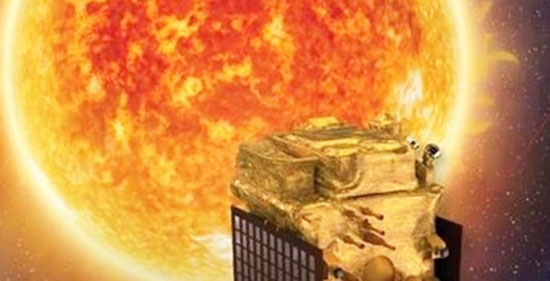The countdown for the Saturday morning launch of India’s third interplanetary mission -- this time to the Sun - Aditya-L1 -- will begin at 12.20 p.m. on Friday, said a senior official of Indian Space Research Organisation (ISRO).
“The countdown will begin at 12.20 p.m. today (Friday),” the official told IANS.
Interestingly, India on August 23 reached the Moon with its lander safely landing on the lunar soil in a textbook style. Later the rover rolled down and started doing experiments.
The Aditya-L1 -- named after the Sun God in Hindu mythology -- will be carried by the Indian rocket Polar Satellite Launch Vehicle-XL variant (PSLV-XL). On Saturday, the rocket will blast off at 11.50 a.m. from the Sriharikota rocket port in Andhra Pradesh, the ISRO said.
During the countdown process, the fuelling of the rocket -- liquid fuel -- will be done as well as checking of its systems.
Initially, Aditya-L1 will be ejected in a low earth orbit (LEO). Then the orbit will be elliptical. As the spacecraft travels towards L1, it will exit the earth’s gravitational Sphere of Influence (SOI).
After exit from SOI, the cruise phase will start and subsequently the spacecraft will be injected into a large halo orbit around the Lagrange Point (L1) -- the point where the gravitational pull of two large bodies will be equal and hence the spacecraft will not gravitate towards any one of the planet.
The total travel time from launch to L1 would take about four months for Aditya-L1 and the distance will be about 1.5 million km from the Earth.
The distance between the Earth and the Moon is about 3,84,000 km.
"A satellite placed in the halo orbit around the L1 point has the major advantage of continuously viewing the Sun without any occultation/eclipses.
This will provide a greater advantage of observing the solar activities and its effect on space weather in real time,” the ISRO said.
According to the ISRO, the spacecraft carries seven payloads to observe the photosphere, chromosphere, and the outermost layers of the Sun (the corona) using electromagnetic and particle and magnetic field detectors.
"Using the special vantage point L1, four payloads directly view the Sun and the remaining three payloads carry out in-situ studies of particles and fields at the Lagrange point L1, thus providing important scientific studies of the propagatory effect of solar dynamics in the interplanetary medium," it said.
Aditya-L1’s seven payloads are expected to provide the most crucial information to understand the problem of coronal heating, coronal mass ejection, pre-flare and flare activities and their characteristics, dynamics of space weather, propagation of particle and fields and others, the Indian space agency said.
The ISRO said the major science objectives of Aditya-L1 mission are: Study of solar upper atmospheric (chromosphere and corona) dynamics, study of chromospheric and coronal heating, physics of the partially ionised plasma, and initiation of the coronal mass ejections, and flares.
It will also observe the in-situ particle and plasma environment providing data for the study of particle dynamics from the Sun.
Other objectives are physics of solar corona and its heating mechanism, the diagnostics of the coronal and coronal loops plasma: Temperature, velocity and density, development, dynamics and origin of Coronal Mass Ejections (CME), to identify the sequence of processes that occur at multiple layers (chromosphere, base and extended corona) which eventually leads to solar eruptive events, magnetic field topology and magnetic field measurements in the solar corona, and the drivers for space weather (origin, composition and dynamics of solar wind).
The Indian space agency said that the Sun estimated to be 4.5 billion years old is a hot glowing ball of hydrogen and helium gases and is the source of energy for the solar system. "The gravity of the sun holds all the objects of the solar system together. At the central region of the sun, known as ‘core’, the temperature can reach as high as 15 million degree Celsius," it said.
At this temperature, a process called nuclear fusion takes place in the core which powers the Sun. The visible surface of the sun known as photosphere is relatively cool and has a temperature of about 5,500 degree Celsius, the ISRO said.
The sun is the nearest star and therefore can be studied in much more detail as compared to other stars. By studying the sun, we can learn much more about stars in our Milky Way as well as about stars in various other galaxies, the ISRO said.
The Sun is a very dynamic star that extends much beyond what we see. It shows several eruptive phenomena and releases immense amount of energy in the solar system. If such explosive solar phenomena is directed towards the earth, it could cause various types of disturbances in the near earth space environment.
Various spacecraft and communication systems are prone to such disturbances and therefore an early warning of such events is important for taking corrective measures beforehand.
In addition to these, if an astronaut is directly exposed to such explosive phenomena, he/she would be in danger. The various thermal and magnetic phenomena on the sun are of extreme nature. Thus, the Sun also provides a good natural laboratory to understand those phenomena which cannot be directly studied in the lab.
The Indians space agency said all the seven payloads carried by Aditya-L1 are indigenously developed by different laboratories in the country in close coordination with it. The Visible Emission Line Coronagraph (VELC) instrument is developed at the Indian Institute of Astrophysics, Bangalore; Solar Ultra-violet Imaging Telescope (SUIT) instrument at Inter University Centre for Astronomy & Astrophysics, Pune; Aditya Solar wind Particle Experiment (ASPEX) at Physical Research Laboratory, Ahmedabad; Plasma Analyser Package for Aditya (PAPA) at Space Physics Laboratory, Vikram Sarabhai Space Centre, Thiruvananthapuram; Solar Low Energy X-ray Spectrometer (SoLEXS) and High Energy L1 Orbiting X-ray Spectrometer (HEL1OS) payloads at U R Rao Satellite Centre, Bangalore and the Magnetometer at the Laboratory for Electro Optics Systems, Bengaluru.




Manipur Police arrest 11 militants, recover large cache of arms, ammunition
The Manipur Police arrested 11 militants belonging to various banned outfits and recovered a large cache of arms and ammunition during the past 24 hours, officials said here on Friday.
PM Modi unveils 21-point action plan at 6th BIMSTEC Summit
Prime Minister Narendra Modi on Friday presented a comprehensive 21-point action plan during the sixth BIMSTEC Summit in Bangkok, laying out an ambitious road map for cooperation across diverse sectors.
ED raids multiple premises of 'Empuraan' producer Gokulam Gopalan
Amid the controversy surrounding Malayalam film ‘Empuraan’ starring superstar Mohanlal, the Enforcement Directorate (ED) on Friday conducted raids at multiple premises linked to film’s producer Gokulam Gopalan.
SC declines PIL seeking restriction of social media platforms for kids below 13 years
The Supreme Court on Friday refused to entertain a public interest litigation (PIL) seeking urgent judicial intervention to regulate access to social media platforms for children below 13 years of age.
BIMSTEC Summit: PM Modi, Yunus meet amid strained ties
Prime Minister Narendra Modi on Friday held a bilateral meeting with Muhammad Yunus, Chief Advisor of Bangladeshi interim government, on the sidelines of the 6th BIMSTEC Summit in Bangkok.
Rupee strengthens against dollar amid Trump's reciprocal tariffs
The Indian rupee witnessed sharp gains on Friday at below 85 against dollar, as the dollar index and oil prices dropped sharply amid concerns over recession in the US economy after the reciprocal tariffs were announced.
Quad to send $20 million relief support to earthquake-ravaged Myanmar
Quad members Australia, India, Japan, and the United States on Friday collectively committed over $20 million in humanitarian assistance to support the relief efforts for the earthquake-devastated Myanmar.
'Waqf Bill will benefit Muslims, no threat to religious sites,' says Shahabuddin Razvi
Maulana Shahabuddin Razvi, the National President of All India Muslim Jamaat, expressed his support for the Waqf (Amendment) Bill, stating that it would significantly benefit Muslims and ensure the betterment of their socio-economic conditions.